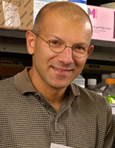The tissue response to injury is a complex and evolutionarily conserved process that is fundamental to many diseases. In the lungs, where a large but very thin barrier separates the organism from the environment, this response faces notable challenges: the host must identify occasional pathogens but ignore a steady barrage of innocuous particles, then generate a rapid and fierce, yet highly localized, response in order to kill the pathogens while maintaining adequate gas exchange, and finally repair the damaged area but halt scar formation in order to minimize permanent loss of gas exchange surface. This process works surprisingly well most of the time; when it does not, the consequences are pneumonia, pathological inflammation, or runaway scarring — the key features of most lung diseases.
We study the mechanisms that mobilize cells from the bone marrow to the lungs via the circulation in the context of human lung disease and relevant animal models. Current projects in the lab include studies of host defense mechanisms in an animal model of invasive aspergillosis, a fungal infection in immunocompromised hosts; experimental therapeutic interventions in antibiotic-resistant Gram-negative bacterial pneumonia; and translational projects in human interstitial lung disease.
